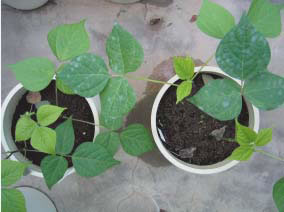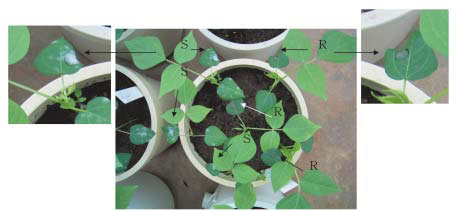Development of powdery mildew-resistant adzuki bean using wild adzuki bean germplasm
Description
[Objectives]
Powdery mildew, or Podosphaera phaseoli, is a serious fungal disease threatening the cultivation of adzuki bean in tropical and subtropical regions. At present, resistant genotypes have not yet been detected in cultivated adzuki bean germplasm. In a greenhouse screening trial at the Okinawa Subtropical Station, we inoculated wild adzuki bean germplasm accessions (mainly collected by JIRCAS) with powdery mildew during their seedling stages by dusting them with spores of infected leaves using a soft brush.
[Results]
Cultivated and wild ancestral forms of adzuki bean (Vigna angularis var. angularis and var. nipponensis, respectively), V. nakashimae and V. riukiuensis were highly susceptible to the disease, whereas V. hirtella exhibited resistance (hypersensitivity). V. hirtella was discovered to have high cross-compatibility with adzuki bean, and we have successfully obtained fertile F1 hybrids from them. These F1 hybrids exhibited resistance like that of V. hirtella when artificially inoculated (Fig. 1). Types of reactions to powdery mildew pathogens on primary leaves of 8 day-old BC1 plants obtained from adzuki bean and V. hirtella were segregated into 24 resistant types (R) and 21 susceptible types (S), with the X2 value for 1:1 segregation being 0.2 (0.7>p>0.5)(Fig. 2).
Judging from this ratio and the resistance found in the F1 plants, it was concluded that a single dominant gene is responsible for the resistance exhibited by V. hirtella. Since the resistance was verified by artificially inoculating all progeny plants, it is anticipated that resistant adzuki bean varieties will be easily obtained through successive backcrossing to commercial cultivars. Currently, we are recurrently backcrossing to cv. 'Erimo shozu' to develop new powdery mildew-resistant adzuki bean varieties.
Figure, table
-
Fig. 1. Types of reactions to the powdery mildew pathogen, Podosphaera phaseoli on F1 plants derived from adzuki bean and V. hirtella (left: resistant) and adzuki bean cv. ‘Erimo shozu’ (right: susceptible). -
Fig. 2. Types of reactions to the powdery mildew pathogen, Podosphaera phaseoli on primary leaves of 8-day-old BC1 plants obtained from adzuki bean and V. hirtella 5 days after inoculation. Resistant leaves are indicated by the letter “R” while susceptible leaves are marked with the letter “S”.
- Affiliation
-
Japan International Research Center for Agricultural Sciences Okinawa Subtropical Station
- Classification
-
Technical A
- Term of research
-
FY2003 (FY2001-2003)
- Responsible researcher
-
EGAWA Yoshinobu ( Okinawa Subtropical Station )
OMAE Hide ( Okinawa Subtropical Station )
SHONO Mariko ( Okinawa Subtropical Station )
KASHIWABA Kouichi ( Okinawa Subtropical Station )
- ほか
- Publication, etc.
-
Egawa, Y., K. Kashiwaba, H. Ohmae and M. Shono (2004): Resistance to powdery mildew pathogens of wild adzuki bean germplasm. Jpn. J. Trop. Agric., 48, Suppl. 1, 63–64.
- Japanese PDF
-
2003_30_A3_ja.pdf2.54 MB
- English PDF
-
2003_30_A4_en.pdf69.72 KB


